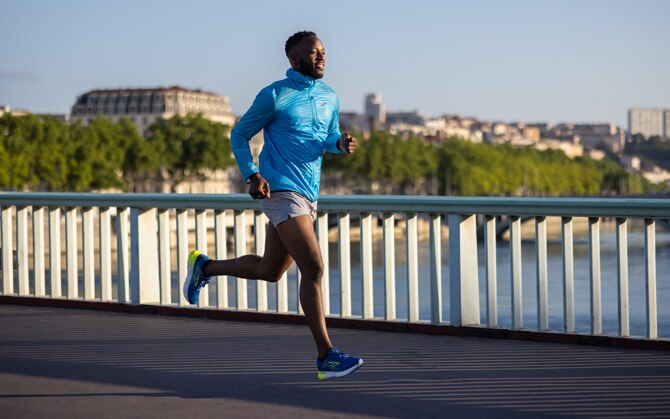How to start running from the ground up

Curious about how to start running? In this article, we'll cover some of the core components of setting up a running routine to ensure you get to your finish line healthy and happy.
When people hear that I run just about every day, have been running since high school, and have run more than 10 marathons, I often hear in response:
- "I could never do that."
- "I've tried to run but just can't do it."
- Or, the most heartbreaking, "I just hate running."
Running certainly isn't for everyone, and I would never advise someone to take it up if they will truly not enjoy it. But if you are interested in learning how to start running, it is possible to start from scratch. I won't sugarcoat it, though. It will take patience, time, and an appropriate training plan to properly build endurance while avoiding injury.
Running is a beneficial exercise for all kinds of reasons, mainly because you can do it almost anywhere and don't need an expensive gym membership or a ton of pricey gear. However, one of the biggest mistakes made by new runners is thinking they can go from 0 to 60 overnight. When people say it's too hard, I explain: No one can wake up and run a mile nonstop having never run consistently before — not even me.
So, here's your route to success.

Invest in the necessary gear
With so many products and fancy gadgets out there, some might argue that running isn't the inexpensive sport it used to be. But that's not necessarily true. There are some items well worth investing in to make sure you're as comfortable as possible and won't be risking injury, but you certainly don't need to go on a spending spree to follow every trend.
Comfortable clothing is one area that is undoubtedly important to focus on. For people with breasts, that includes finding a supportive running bra for your body type. The Brooks Running Bra Finder tool can help you find your best fit while choosing from a variety of styles.
Similarly, finding the right running shoes is also super important. If you are brand new to running, it makes sense to visit your local running store in person to find the best shoes for you. Many running store associates will have you test shoes to find a pair that fits well and feels comfortable. They might also make a recommendation based on whether you pronate (i.e. whether your foot rolls inward or not upon impact). Once you're advancing in your running journey and want some extra guidance in choosing a shoe for a training goal, the Brooks Shoe Finder can be a helpful resource.
Another key piece of gear? Shorts — especially if you live in a hot and humid climate like I do here in Houston, Texas. I prefer tight shorts that aren't so short they'll ride up or chafe me and that have decent-sized pockets to store my energy gels and house or car key. The Brooks Method 5" Short Tight covers all these bases, and they're the shorts I trained in and wore during this year's Houston Marathon, where I ran my first-ever Boston Marathon qualifying time.
Fuel and hydrate properly
I'm not a dietitian or nutrition professional, so I hesitate to give blanket advice on fueling properly before and during runs. Everyone is different, and what works for someone else might not work for you. Therefore, it's best to use trial and error to determine what keeps you most energized on a run.
Hydration, on the other hand, is arguably more important to focus on, especially since most runners could probably stand to be drinking more water both on and off a run. Here in Houston, my other must-have piece of gear is a handheld water bottle for hydration, which I take with me on runs of any distance in the summer months. I'll usually fill it up and freeze it overnight, as it'll melt down to ice-cold water fairly quickly once I get moving. If I'm on a run lasting longer than an hour, I'll most definitely be stopping to refill it at a water fountain more than once.

Consider the conditions
One of the best ways you can stick to a running plan is to make it a habit to fuel your motivation. In order to stay motivated, it's important your runs are as enjoyable as possible. Consider the conditions, and plan out the safest time to run. In the summer, that might mean early mornings to avoid heat exhaustion. In the winter, that could mean midday to avoid running on dark, icy roads when your chance of injury is higher and it's more difficult for drivers to see you if your clothing isn't bright or reflective enough.
Another key component of setting up a comfortable routine is figuring out some go-to routes. Do you live near any parks with trails and tree cover for shade? Is your neighborhood pretty low-traffic and safe for running on the roads or sidewalks? Nailing down a few options you can rotate between is helpful to avoid monotony.
If it's not possible to get out at optimal times or you're experiencing severe weather and you have access to a gym or treadmill, by all means, use it. A treadmill is an excellent tool to get a run in. If you have your smartphone or a tablet, you can catch up on your favorite TV show or podcast while you get your workout in, which could also help with motivation when you're just not feeling it.
Take steps to avoid injury
Any runner who is starting from zero should start with a run-walk plan and work their way up to running a nonstop 5K race before pursuing longer distance goals. The key, however, is consistency. You don't want to pile on too much too soon and risk getting injured. Being inconsistent in your training and then trying to ramp up the mileage is a recipe for disaster as well.
You should run the majority of your runs at an easy, conversational pace. This is a concept that is difficult for many new runners as they target a goal race, but once you have a time goal on the horizon, your easy pace should be at least 45 to 90 seconds slower than your goal race pace. To put this in context, when I trained for my Boston-qualifying race last year, which I completed in 3:30:14 (6:20 average pace per 1 kilometer), none of my easy or long runs averaged faster than 8:39-8:49 per 1 kilometers, unless it was a prescribed race-pace workout. In addition to helping you avoid injury, this is also important for recovery.
Finally, one of the biggest components of avoiding injury is to listen to your body when it's asking you to rest. Does something hurt? Do you have slight discomfort in your knee, calf, hip, or foot that's causing you to alter your gait when you run? Take a day off, or better yet, a few, to rest it. Missing a day, or even a week, won't make or break your performance. Pushing through pain or discomfort, however, could lead to a full-on injury that might cause you to have to sit out of your running routine altogether. Trust me, I speak from experience.

Consider working with a coach
As mentioned, it can be beneficial to start with a run-walk program if you're just getting started. This program will have you doing intervals of running and walking before eventually phasing out the walk breaks. Starting with a run-walk program is a great way to work toward a common first milestone of completing a 5K race or even just a single mile without walking or stopping. Once you've reached your first milestone, then you can consider pursuing other long-distance milestones, assuming you enjoyed it and want to keep going.
However, as a newly-certified USATF Level 1 running coach, I believe any runner at any level should consider working with a coach to get an individualized training plan. This is because runners' needs can vary greatly. If it turns out you're more injury-prone than some of your training buddies, that doesn't mean running isn't for you. It just means you may benefit from lower-mileage, supplemental cross-training, and perhaps an extra day of rest per week. I learned this the hard way. After dealing with injuries, overtraining, and burnout trying to train at the same high mileage as my friends, I finally invested in a coach who helped me nail down a training program with lower, more quality mileage. In the end, I met my ultimate goal of qualifying for Boston after peaking with one 80-kilometer week — a far lower volume than most of my running peers.
A coach can also help you nail down specific target training paces and meet yourself where you're at when it comes to setting realistic goals. A basic online plan may not factor in individual life circumstances that make it hard to get certain assigned runs or workouts in. It's easy to give up on your goals if the training process becomes overwhelming. A coach, meanwhile, can take those factors into account and tweak your plan to fit your needs so you stay motivated.
With these tips in mind, you're ready to take the first step on your running journey — one that is sure to bring physical and mental health benefits for years to come!
Our writer's advice is intended for informational or general educational purposes only. We always encourage you to speak with your physician or healthcare provider before making any adjustments to your running, nutrition, or fitness routines.

